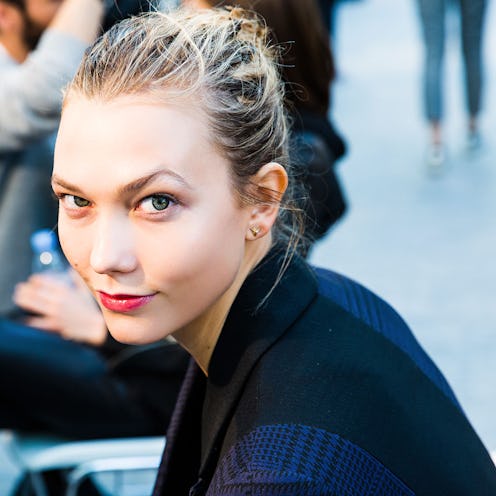For being such a small part of one’s beauty routine, there is a lot to know about concealer. A tiny yet mighty product, concealer can be a serious game-changer if applied properly and thoughtfully—as in, your complexion can go from ho-hum to flawless in seconds flat. Here to break down the golden rules of the almighty formula is Kira Nasrat, makeup artist and Violet Grey brand ambassador, who has worked with names including Gwyneth Paltrow, Margot Robbie, Rosie Huntington-Whiteley and Jamie Chung. Ahead, everything you need to know about using and choosing the right products for spectacular, spot-free skin.
The Golden Rules Of Concealer
"Prepping the skin is one of the most important steps before applying anything else—when your skin feels and looks its best you don’t need a lot of product. In order to achieve smooth coverage, first lightly exfoliate so you're not putting makeup on top of dry, flaky skin. To moisturize, follow with a serum then a face cream that suits your skin type (I prefer Sisley's Black Rose oil layered under La Mer's soft cream). Then, do a gentle facial massage to get blood circulation going—I always notice that people have a little glow after this process. To finish, prime the skin with an oil-free base and your skin will be ready for foundation and/or concealer. For best results, wait a beat after each of these steps so that the skin takes in everything it needs to from the products and has time to set."
"I recommend using a very small amount of foundation first just to even out the skin tone—all you need is a thin layer. Then, apply concealer only where needed. Some people don't need a full face of coverage, but if you do, applying foundation first ensures you don’t go over your perfectly blended concealer and mess with everything you just worked so hard to perfect. For lighter coverage, you can also use a tinted moisturizer instead of a foundation all over and then conceal the areas that need some extra help. The most common mistake that people make is that they use too much product in places where it’s not needed and skin doesn't look like skin. Less is more and you have to make sure that whenever you're using any kind of concealer, you blend, blend, blend!"
"First and foremost, make sure your delicate under-eye skin is moisturized so product goes on smoothly. For blue hues under the eye, try a peach-toned concealer (NARS Ginger for darker skin tones, Honey for lighter skin tones) and for purple hues, use a yellow-toned concealer (Kevyn Aucoin Sensual Skin Enhancer in SX9, YSL Touche Eclat in 2.5 Luminous Vanilla). For redness under the eye, try a green-toned product. Use a flat concealer brush to lightly pat product on the skin—your under-eye area is very delicate so try to avoid pulling or rubbing. Use the tip of your ring finger—it’s the weakest finger on your hand, so it acts gently—to pat around the edges so concealer blends seamlessly. After you cancel out any unwanted color tone, finish with a thin layer of product one shade brighter than your skin tone over the under-eye area, avoiding the outer corners, to illuminate the area."
"Make sure the areas on and around your blemishes are not flaky and dry—this is really crucial. To insure a flake-free zone, gently exfoliate and moisturize. If the skin is red, apply a green-tinted product to neutralize the spot. Then apply a concealer closest to your skin tone by gently patting the product onto the area. If the blemish is not a flat surface and is raised, you’ll want to use your concealer brush to apply product on the area then use a Beautyblender sponge to press it gently onto the blemish. This will make the challenged area look more natural, as this sponge does a great job mimicking the pores of your skin (and doesn't make it look like the area is simply covered in makeup.)"
"Drawing an upside-down triangle shape under the eye for coverage is a popular technique and it’s pretty helpful. This doesn’t apply all the time since not everyone needs as much coverage in the area, so I suggest you first assess what you are trying to conceal then draw your triangle accordingly. Anytime you’re using a creamier concealer with a thicker consistency, try warming it up by blending it on the back of your hand and then applying it with a brush or your finger. When you’re using a concealer to brighten certain areas under the eye, start in the center of the face blending outwards. This will look more natural without any harsh lines—use your fingers to blend out any edges for as seamless finish."
"There is never a time when I only use one shade of concealer for everything. In your everyday arsenal, I recommend having at least 3 basic shades: a peach formula to cancel out any blue tones, a shade that is closest to your foundation and one shade that is slightly brighter to make the under-eye area pop."
"To cover up darker blemishes on the face, a thicker, creamier concealer is best, as it typically doesn't move as much as the liquid based concealers do. Laura Mercier's Secret Camouflage and Kevyn Aucoin's Sensual Skin Enhancer are amazing examples—once you apply and blend these, you can count on them to stay in place even without a setting powder. A liquid-based concealer, such as Giorgio Armani's Concealer Maestro Eraser, is great for someone without serious under-eye challenges or blemishes and just needs a thin, corrective veil. To brighten the under-eyes, the YSL Touche Eclat looks great layered under the RMS Living Luminizer for a luminous effect."
